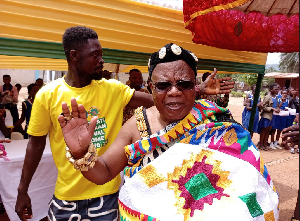 Barima Ati Awuah Kwaako, Atihene of Akyem-Hemang
Barima Ati Awuah Kwaako, Atihene of Akyem-Hemang
Residents of Ati in the Eastern Region have established an education endowment fund to help brilliant pupils and students in the area.
Barima Ati Awuah Kwaako, Atihene of Akyem-Hemang, announced this when he addressed a durbar to climax the celebration of this year’s Ohumkan festival at Ati.
Underscoring the essence of the fund, the Sanaahene reiterated that the only legacy the community could leave their children was education. He stressed the importance of investing more resources in educating their children and wards to ensure they become responsible citizens in the future.
Barima Ati Awuah Kwaako expressed concern about the inability of a large number of youth in the area to pursue higher education due to poverty. He stated that the fund would greatly help address this issue in the community.
He urged the people to promote unity and cooperation among themselves to enable them to collectively initiate and execute development projects.
He further explained that the establishment of the fund is aimed at assisting disadvantaged children in the Ati area, emphasizing that education is crucial in uncovering the talents of the potential beneficiaries.
“Today, we launch the Ati Educational Fund, a noble initiative dedicated to helping our community's brilliant but needy schoolchildren. Education is the key to unlocking potential, and this fund will provide vital support to those who need it most,” the chief asserted.
Emphasizing why citizens of Ati must prioritize contributing towards the fund, the chief noted that children reserve the right to good education as the main drive for underdevelopment.
"Every child deserves access to quality education, regardless of their background or financial situation,” he stated. “By supporting the Ati Educational Fund, we invest in our community's future, fostering a generation of leaders who will drive progress and prosperity.”
The Ohum festival:
Barima Ati Awuah Kwaako, while explaining the essence of the Ohum festival, said, "The Ohum Festival is more than just a celebration; it's a symbol of our unity, resilience, and gratitude to our ancestors. It's a time to reconnect with our roots, honor our heritage, and showcase our vibrant cultural diversity."
Expanding on this, the traditional leader added, "Through music, dance, and feasting, we come together to strengthen our bonds, resolve conflicts, and seek blessings for a prosperous future."
Okatakyie Nana Anim I, Sanaahene for Ati, urged the youth to unite for the development of the Ati community and the country as a whole.
He appealed to them not to engage in any acts of violence during the December general elections and to disregard politicians who seek to involve them in disturbances during the process.
The Ohum festival reflects the core Akan belief in the unity of life of the dead, the living, and the yet unborn. The symbolic essence, the principle of balance, moderation, and regeneration, is an immeasurable contribution to the struggle for ecological integrity as a prerequisite for the sustenance of humanity.
The chief proposed the establishment of an annual Ati Educational Fund Week to ensure the fund's sustainability and provide a platform to raise funds to support the noble cause.
Gertrude Mensah, chairperson of the Ati Educational Fund committee, noted that many brilliant but needy children in the Ati community, especially senior high school graduates seeking to further their education, needed support.
She identified the lack of funds on the part of parents as the root cause of the situation.
The former Eastern Region Director of Education expressed confidence in the committee's ability to mobilize the necessary funds and appealed to all Ati residents, both at home and abroad, to contribute to the fund.
Mr. Adu Eric Amos, Branch Manager of the Tafo Branch of the Atiwa Rural Bank and Sanaahene of Akyem Hemang, praised the fund as a commendable idea that could address the challenges facing young people in the community. He stated that the bank was committed to supporting the Ati Educational Fund by providing vocational skills training to empower the youth.
He mentioned that the youth would receive training in tie and dye making, soap making, food services, etc., to create employment opportunities and generate income for them.